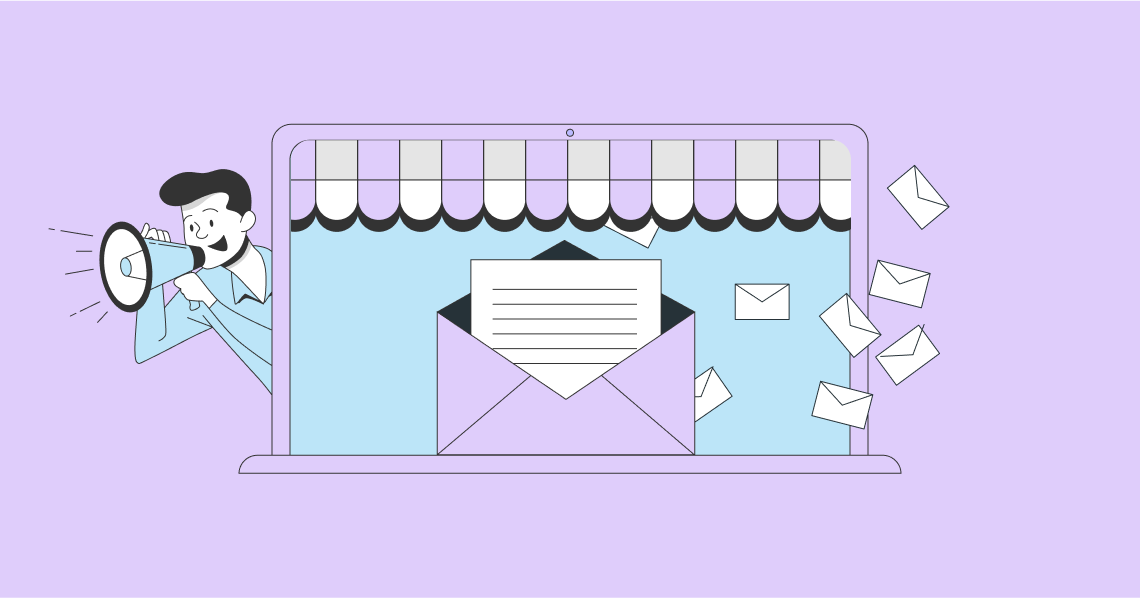To email or to text? That doesn’t have to be a question. Several software solutions include email as well as SMS marketing features.
Sure, you can invest in a platform for your email marketing and then in another tool for your SMS marketing. But that’s basically like getting a social media management platform for each social network. It’s completely unnecessary and definitely not the best approach if you want to streamline your marketing efforts — the reason for investing in this type of tool in the first place.
Now that you know that you can easily communicate and promote across both channels, here’s a quick look at why you should.
Key Email and SMS Marketing Statistics
- SMS has an open rate of as high as 98%. What’s more, the majority of buyers will view your brand more positively if it sends SMS notifications.
- While the average open rate is much lower for email, email marketing statistics reveal that email marketing can generate a return on investment (ROI) of over $40 per dollar spent. That’s massive!
- If you’re operating in the B2B space specifically, email can be an invaluable tool for communication too. About half of B2B buyers email their order, while more than 40% use it for purchasing decisions, according to our B2B email marketing stats.
To sum up, with email and SMS, you’ll know that your message will get opened without having to spend too much. It’s not a social media post lingering in someone’s feed that might get scrolled past. It’s this direct line of communication that email and SMS offer that makes it an essential part of your communication and marketing strategies.
What Are Email and SMS Marketing Software?
Email and SMS marketing software are comprehensive platforms designed to help businesses effectively communicate with their audience through email and text messaging. These tools facilitate the creation, management, and automation of marketing campaigns, allowing businesses to send promotional offers, transactional updates, and informational content directly to customers' inboxes or mobile devices.
Additionally, email and SMS marketing software typically include drag-and-drop editors, templates, and personalization options, making it easy to design professional-looking emails and text messages that resonate with your audience. They also offer analytics and reporting tools that track open rates, click-through rates, conversions, and other key metrics, providing valuable insights into campaign performance and helping businesses refine their strategies over time.
10 Leading Software for Email and SMS Marketing
1. Campaigner

Campaigner is almost as old as email itself. Founded in the late 1990s, it has grown to become one of the leading email marketing tools with several offices across North America and a client list that includes several Fortune 500 companies and names like Whirlpool, Xerox, and TripAdvisor.
Needless to say, if you’ve been that long in business, you should’ve received countless online reviews to back up your capabilities. Not only does Campaigner have hundreds of reviews on Capterra, but they’ve also been featured in several of their recent shortlists as a noteworthy product and established player.
As for features, Campaigner includes several automation features to help you reach your target audience at the right time in the customer journey. What makes it such a great tool for email and SMS marketing is that you can use it to send text messages directly via its platform as part of a standalone SMS marketing campaign or as part of your email workflow.
Key features include:
- Geolocation targeting
- A free phone number
- Segmentation
- Autoresponders
- Recurring SMS campaigns
- Personalized SMS content
Plans and pricing: Campaigner offers a number of subscription plans. For the ability to use email and SMS marketing, pricing starts at $59 per month after a generous free 30-day trial.
2. Brevo (formerly Sendinblue)

Unlike Omnisend that zooms in on eCommerce sellers, Brevo also serves as a marketing partner for businesses operating in the B2B and B2C space as well as marketing agencies. It describes itself as an all-in-one digital marketing platform that can help growing SMBs with their marketing tasks.
It’s trusted by half a million users for sending millions of emails every single day. Notable email marketing features include its automation and personalization. Both these features have been rated as above average.
In addition to emails, it also supports SMS marketing. You can use it to send bulk SMS marketing campaigns, WhatsApp campaigns, or important transactional text messages like order confirmations or shipping updates. As transactional messages are often time-sensitive, it offers real-time deliverability reporting and engagement stats, helping you to monitor results.
All in all, it’s one of the most reviewed products. It boasts thousands of online reviews on popular review sites like G2 and Capterra.
Key features include:
- Customizable email templates
- A drag-and-drop editor
- Email and SMS personalization
- A/B testing
- Advanced segmentation
- Customizable sign-up forms
Plans and pricing: Brevo offers a number of subscription plans, including a free plan and custom pricing for enterprise clients. Pricing starts at $25 per month and SMS credits can be purchased for as little as $1 for 100 mobile text messages in the US.
3. Omnisend

If you’re running an eCommerce business, be sure to check out Omnisend. It’s an eCommerce-tailored SMS and email marketing automation platform that integrates with a long list of popular eCommerce platforms and tools like Shopify, Yotpo, and Typeform.
It started out as an email marketing tool, but, as its name suggests, it expanded its scope to help users launch and implement an omnichannel marketing approach. Fast-forward three years after it was founded and it added SMS as another channel for automation and marketing campaigns. Over the years, it has also received a lot of recognition and has been included for many consecutive years in several of Capterra’s shortlists both as an emerging favorite and top performer.
What makes it such a great tool for eCommerce purposes is that it offers several features aimed at this niche specifically. It, for example, includes pre-built eCommerce workflows. These workflows can be used for key tasks like cart abandonment and post purchases, helping to save time. Templates that you use to share personalized product recommendations to help with upselling are also included in its email templates selection.
Key features include:
- Email and SMS automation
- Several sales and performance reports
- Unlimited segmentation
- A/B split testing
- A dedicated toll-free US sending number
Plans and pricing: To access both its email and SMS features, pricing starts at $16 per month. A free trial (no credit card required) is also available.
4. ActiveCampaign

ActiveCampaign provides premier customer experience automation. The Chicago-based company specializes in all-in-one automation, email marketing, and sales engagement. It helps build responsive, effective, and always-on workflows that exceed your customers’ expectations. It assists in growing your reach with more innovative campaigns. Its email, SMS, and cross-channel tools power compelling experiences that trigger more opens, clicks, and actions. This omnichannel strategy enables you to capture more relevant leads.
The platform automates marketing for businesses of all sizes while maintaining the personalized touch of text messages, emails, and social media posts. Its intelligent multichannel automation seamlessly connects campaigns across the channels that matter the most to your business. It fuses email marketing, SMS marketing, split testing, social and ad audiences, deliverability, and dynamic content to help you find and convert potential customers by reaching them where they’re most engaged.
As a unified platform, ActiveCampaign seamlessly integrates email and SMS marketing. You can design your responsive email or choose one from the 250+ templates it offers. Use the pre-designed template to customize your email messages, newsletters, and campaigns. Personalize the content based on subscriber data and then trigger automated SMS for follow-ups. Doing all this in one platform eliminates the need to use different tools and juggle other tasks. It also ensures that you are consistently sending messages across channels.
Because ActiveCampaign’s strength lies in its marketing automation features, you can easily set up operations that automatically send targeted emails and SMS based on consumer behavior. For example, an abandoned cart email on Shopify can be followed by a reminder SMS to nudge the customer to complete the purchase. You can also send shoppers SMS updates for discounts inspired by their last purchases.
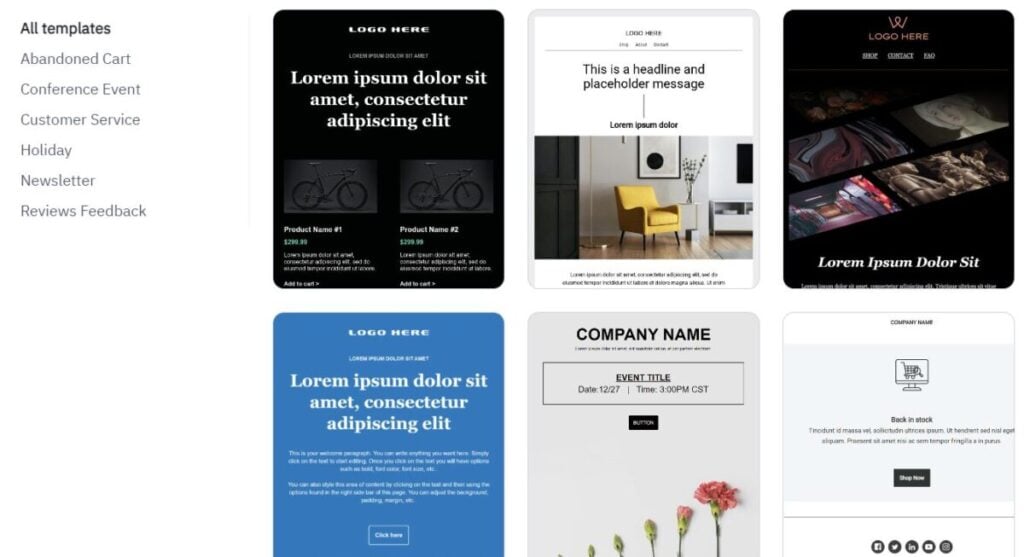
ActiveCampaign has over 5,100 verified reviews in G2 regarding building and personalizing emails. The overwhelming consensus is that the platform is intuitive, economical, and effective. You can efficiently manage email templates to mirror your brand’s tone and personalize your content to align with your brand image. The platform’s drag-and-drop email builder and intuitive automation workflows don’t require extensive technical expertise.
Shopify is not the only platform that you can effortlessly integrate with ActiveCampaign. The software is compatible with over 940 applications. For instance, you can incorporate ActiveCampaign with:
- Salesforce, Dropbox Sign, Instabot, and OnePageCRM for sales
- Google Analytics, OneSendHQ, Zoho Analytics, and Snowflake for analytics
- eBay, Magento, Square, and WooCommerce for eCommerce
ActiveCampaign’s segmentation features also help personalize emails and SMS. The software lets you tag (their preferred term over segment) your target market based on demographics, purchase history, personal interest, website interactions, CLV, and more. Tag also lets you sort, group, consolidate, send, and automate.
Every time a lead makes an action, you can tag it accordingly and send individualized content based on the tag. These insights help create and send highly personalized emails and SMS that resonate better with each subscriber. With this feature, you can send birthday discount codes via SMS or recommend relevant products based on past purchases through emails.
A research report involving ActiveCampaign suggests that the market for marketing automation software is expected to increase by nearly 12% between 2022 and 2027. This shows how effective and essential automation software can be in helping businesses of all sizes succeed and scale. With ActiveCampaign’s encompassing services, brands like Paperbell, Bonjoro, Caffeine Army, and Alclair have found success. Specifically, its email campaign with Your Therapy Source has yielded a 2000% return on money invested in the software.

Key features include:
- Multi-user editing
- Integrations
- Managed deliverability
- Custom data
- Audience segmentation
- Site tracking
- Geotracking
- Free image hosting
- Social sharing
- Analytics
- Link actions
- Mobile optimization
- Conditional content
- Revision history
Plans and pricing: ActiveCampaign offers four pricing plans: Starter at $8/month (50% off for the first 3 months), Plus at $49/month, Pro at $79/month, and Enterprise at $145/month, with increasing features and support at each level.
5. Keap

Entrepreneurs and small businesses can keep an eye on Keap. It’s one of the leading CRM software solutions for small businesses and has helped hundreds of thousands over the span of two decades.
Included in its list of features are email and text marketing. It offers stunning email templates, but you’re also welcome to come up with your own design. Then, to help your emails reach the right audience you can automatically segment your contacts that you can store in its CRM using criteria like behavior and industry.
The same applies to its text marketing functionality. There are templates to get you started quickly and you can personalize messages with segment broadcasts and customer data. Plus, your recipients can also reply to your automated broadcasts to ensure effective two-way communication. However, unlike some of the other tools on our list, Keap’s text marketing is currently available only in the United States.
Key features include:
- Sales and marketing automation
- Lead and client management
- A/B testing
- Reporting and analytics
- Built-in compliance
- Customizable opt-in messaging
Plans and pricing: After a 14-day free trial (no credit card required), pricing starts at $159 per month when billed monthly for up to 1,500 contacts and two users. The text service is available as a paid add-on with pricing starting at $9 per month for 500 messages. However, if you choose to pay annually, you can save a generous 20%.
6. Klaviyo

Klaviyo has been automating customer retention for over a decade. It’s a great tool and, as we mentioned in our dedicated Klaviyo review, the choice to use Klaviyo for customer retention should come to you as automatic as the text and email messages that it sends.
Compared to some of the other tools on this list, the learning curve involved is slightly steeper. That being said, it shares a number of email marketing best practices during the setup phase. Plus, its email templates have also been created with these best practices in mind.
One standout email feature that deserves special mention is its advanced segmentation. You can set up various rules and conditions, such as customers who’ve bought a product in the last month, to reach specific segments. Combine that with its automated flows and 300+ available integrations and you have one super powerful tool for eCommerce marketing. Plus, as it offers a number of pre-built flows, there’s no need to start from scratch (though, you’re welcome to do that too).
Klaviyo SMS allows for two-way texting, which can delight customers who receive human responses when they reply to messages. Additionally, the built-in contact cards ensure that businesses appear with their recognizable identities rather than as anonymous numbers.
Key features include:
- A drag-and-drop automation builder
- A/B testing
- Marketing reports and benchmarks (for email as well as SMS)
- Pre-built sign-up forms
Plans and pricing: Klaviyo bases its pricing on the number of contacts. It offers a free plan that includes 500 email sends per month and 150 free monthly SMS credits. If you want to reach your customers by means of SMS and email, pricing starts at $60 per month.
7. GetResponse

Aimed at businesses of all sizes, GetResponse is a comprehensive email marketing platform that also includes SMS marketing. It’s one of the most popular alternatives to Klaviyo and is used by hundreds of thousands of brands across the world that include major names like Zendesk, IKEA, and Stripe.
It can help you to send bulk SMS campaigns automatically, but not at the expense of personalization. You can use conditions like use behavior as triggers to refine your campaign. Then, to improve open rates, you can, for example, personalize the sender name or use its Time Travel and Perfect Timing tools (these tools can also help you to send emails that are perfectly timed).
As for its email features, it offers all the standard features that you’ve come to expect like a drag-and-drop builder, templates, and action-based automated emails. It’s the automated email responses in particular that users have rated as one of GetResponse’s best-rated features.
Transactional emails are also available as a paid extra.
Key features include:
- Landing pages
- AI-powered product recommendations
- Segmentation
- A/B testing
- Automated email and SMS campaigns
Plans and pricing: GetResponse offers several subscription plans, including a free plan. However, to be able to use its email and SMS marketing features, you’ll need to sign up for its MAX plan which costs $13.12 per month.
8. Zoho Campaigns

Zoho is another email marketing software solution that you can check out if you operate in the eCommerce niche. From automated workflows to responsive designs, it offers several tools to improve your email marketing strategy. It’s also straightforward to use, thanks to its intuitive drag-and-drop editor which lets you personalize your content for better engagement. In addition to personalization, it also includes autoresponders to ensure that engagement doesn’t drop during the nurturing process.
While it classifies itself mainly as an email marketing tool, Zoho Campaigns also include SMS marketing to help you reach more of your contacts and double the efforts of your marketing strategy.
Key features include:
- Interactive elements such as surveys, videos, and polls
- A/B testing
- Email send-time optimization
- Segmentation
- Email templates
Plans and pricing: Zoho Campaigns base their pricing on the number of contacts that you manage. Not only do they offer a free 14-day trial and free forever plan, but their pricing is also very reasonable. Pricing starts at only $3 per month for up to 500 contacts.
9. MessageBird

MessageBird’s mission is to simplify communication between businesses and customers (and they don’t do this by limiting the number of communication channels). As it’s an omnichannel automation platform for marketing, it can be used to automate all touchpoints across various channels. In addition to email and SMS marketing, it also supports WhatsApp, Instagram Direct, Facebook Messenger, and Google Maps.
As for email marketing, they’re rated as one of the most reliable email senders and help brands to send trillions of emails each year. In addition to their reliability, enterprise clients also turn to them for speed and security.
Their SMS service is equally reliable. MessageBird has direct connections with more than 240 carriers to ensure impressive deliverability across the globe.
Then, to help you leverage the power of both email as well as SMS marketing, it offers an easy-to-use, drag-and-drop builder that you can use to create automated flows. This means that you can customize the journey without needing to write a line of code.
Key features include:
- Real-time email delivery monitoring
- SMS and email insights
- Real-time email campaign tracking and reporting
- Bulk messaging
- Email health score alerting
Plans and pricing: MessageBird offers flexible pricing. Instead of charging you a monthly fixed fee, you pay only for the messages and interactions that you need. Its SMS pricing is about $0.008 per message in the United States. Its email pricing starts at about $20 per month for up to 50,000 monthly emails.
10. Campaign Monitor

Not to be confused with Campaigner, Campaign Monitor offers equally impressive email marketing and automation tools. It’s trusted by thousands of businesses, including names like Rip Curl and Digiday. For more social proof, Capterra has recently also shortlisted it as an emerging email marketing software favorite.
Included in its list of features are a drag-and-drop builder, visual journey designer, and real-time performance metrics to mention only a few. It also includes a few team management features that you can use to set up roles and permissions helping you to ensure that your branding gets applied consistently.
In addition to email marketing, it also recently added SMS functionality. With Campaign Monitor in your MarTech stack, you can launch a new SMS marketing campaign in a matter of minutes. Then, to help ensure that your copy is effective and in line with industry regulations, it includes a link shortener and automatically added opt-out copy.
Key features include:
- Customizable, responsive email templates
- Segmentation tools
- An image gallery with millions of free Unsplash photos
- Real-time reporting
- A/B testing
- Transactional emails
- Send-time optimization
Plans and pricing: Pricing starts at $12 per month. Alternatively, if you know that you’ll be sending emails only occasionally, you can also sign up for its pay-per-campaign option that charges only $5 per campaign and 1¢ per recipient.
Key Benefits of Using Email and SMS Marketing Apps
Email and SMS marketing software offer numerous advantages that can significantly enhance your marketing efforts. These platforms provide a direct line of communication to your customers, allowing you to craft personalized messages, automate campaigns, and gain insights that help you optimize your strategy. Below, we’ll explore some of the key benefits in more detail.
1. Reach Your Customers Directly
Email and SMS are among the most personal communication channels available to businesses. Unlike social media or paid advertising, where messages are often dispersed among a sea of content, emails and text messages land directly in your customers' inboxes and mobile devices. This direct line of communication ensures that your messages are seen and increases the likelihood of engaging your audience. By reaching customers where they are most attentive, you can foster stronger relationships and encourage repeat interactions.
2. Increase Engagement
Well-crafted email and SMS campaigns can achieve significantly higher engagement rates than other marketing channels. Personalization options allow you to tailor messages to individual recipients, making them more relevant and compelling.
Whether it’s through targeted offers, personalized product recommendations, or timely reminders, these platforms enable you to create messages that resonate with your audience, driving higher open rates, click-throughs, and conversions. The ability to segment your audience further amplifies this effect, ensuring that each customer receives content that meets their specific needs and interests.
3. Automate Your Campaigns
One of the standout features of email and SMS marketing software is automation. These platforms enable you to set up a variety of automated campaigns, such as welcome emails for new subscribers, abandoned cart reminders for potential buyers, and appointment confirmations or reminders for service-based businesses.
Automation not only saves you time but also ensures that your messaging is consistent and timely, reaching customers at optimal moments without the need for manual intervention. This can lead to more efficient marketing operations and a smoother customer journey.
4. Gain Valuable Insights
Understanding the effectiveness of your campaigns is crucial for continuous improvement, and email and SMS marketing software provide detailed reporting and analytics to help you do just that. These platforms offer insights into key metrics such as open rates, click-through rates, conversion rates, and even customer behavior patterns.
By analyzing this data, you can identify what’s working well and what needs adjustment, allowing you to refine your campaigns and maximize their impact. This data-driven approach ensures that your marketing efforts are always evolving and improving.
5. Save Time and Resources
Efficiency is a significant advantage of using email and SMS marketing software. With centralized contact management, you can easily organize and segment your audience, making it simple to target specific groups with tailored messaging. Intuitive campaign builders, often featuring drag-and-drop functionality and customizable templates, allow you to create professional-quality campaigns quickly and with minimal effort.
How to Choose the Right Email and SMS Marketing Software
Choosing the right email and SMS marketing platform is critical to the success of your marketing efforts. The ideal solution should align with your business needs and goals, offering features that support your specific requirements. Below, we’ll explore key considerations to help you make an informed decision.
Easy Contact Management and List Segmentation
Effective contact management is the backbone of any successful email and SMS marketing campaign. Look for a platform that makes it simple to organize, segment, and manage your contacts. For example, Campaigner offers robust segmentation features that allow you to target your audience based on demographics, behavior, or purchase history. This ensures that you can send highly targeted messages that resonate with specific groups, leading to better engagement and conversion rates.
Additionally, platforms like Keap allow you to store and segment contacts within its CRM using criteria like industry and customer behavior, making it easier to reach the right audience at the right time. Proper segmentation is crucial for maintaining organized and efficient campaigns, especially as your contact list grows.
Drag-and-Drop Email Builders and SMS Templates
Creativity and ease of use are essential when designing your marketing campaigns. Platforms that offer drag-and-drop builders and customizable SMS and email templates allow you to create visually appealing and effective messages without the need for coding or design skills.
For instance, Brevo (formerly Sendinblue) provides a user-friendly drag-and-drop editor and customizable email templates, making it easy to create professional campaigns that align with your brand identity.
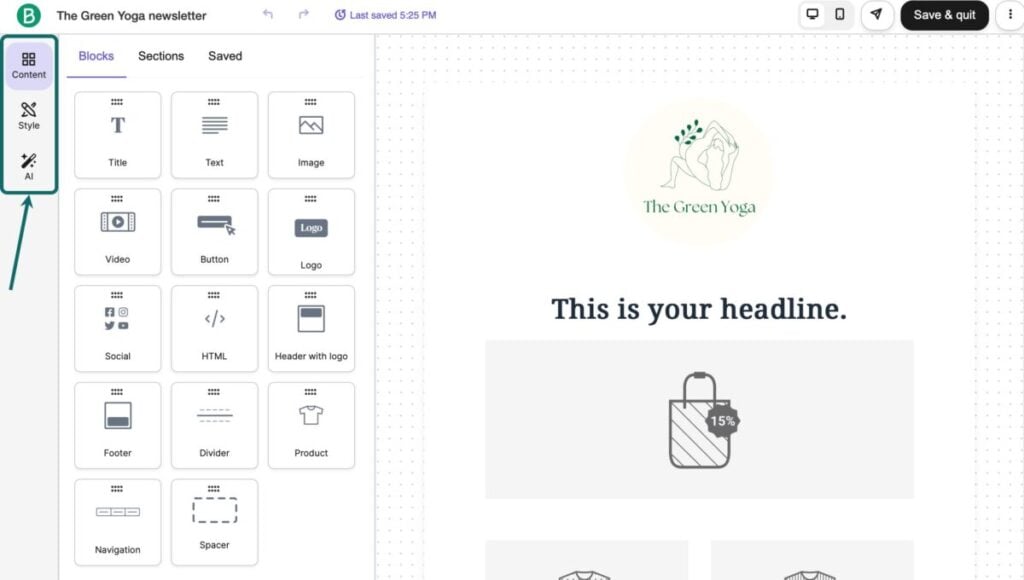
Source: Brevo
ActiveCampaign also excels in this area, offering over 250 email templates that can be customized using its intuitive drag-and-drop builder. These tools not only save time but also ensure that your campaigns look polished and are consistent with your brand's voice. The flexibility and ease of use these platforms provide can lead to more engaging and impactful campaigns.

Source: ActiveCampaign
Automated Workflows and Triggered Messages
Automation is a game-changer in email and SMS marketing. When choosing a platform, prioritize one that offers robust automated workflows and triggered messaging capabilities. Omnisend is a great example, especially for eCommerce businesses, as it offers pre-built eCommerce workflows for tasks like cart abandonment and post-purchase follow-ups. This allows you to set up automated campaigns that run based on customer actions, ensuring timely and relevant messaging without manual intervention.
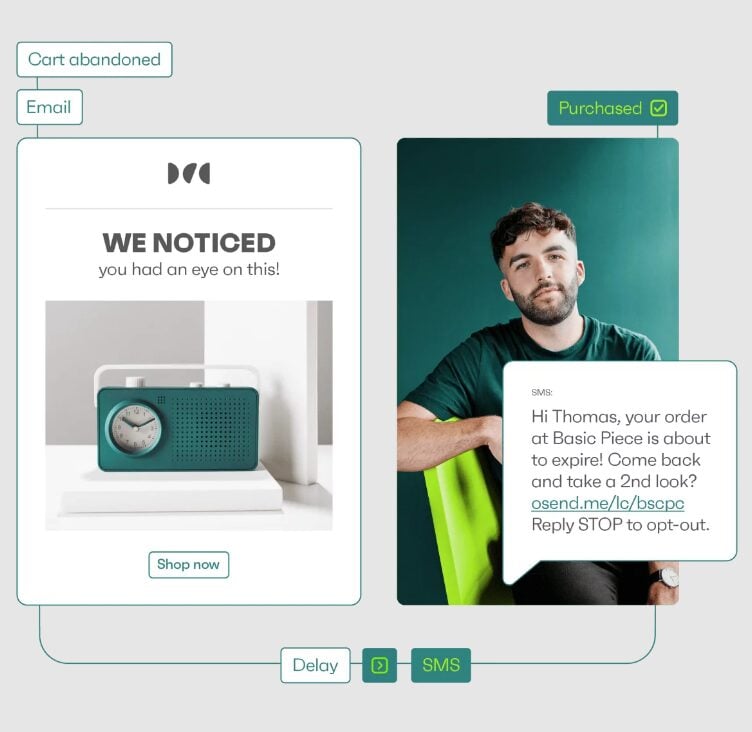
Source: Omnisend
ActiveCampaign takes automation a step further by enabling multi-channel campaigns that connect email, SMS, and social media touchpoints seamlessly. For instance, an abandoned cart email can be followed by an SMS reminder, increasing the likelihood of conversion. These automated processes are essential for nurturing leads, driving conversions, and maintaining customer engagement efficiently.
Detailed Reporting and Analytics
Data-driven decision-making is crucial in marketing, making detailed reporting and analytics a must-have feature in your email and SMS marketing software. Brevo provides real-time deliverability reporting and engagement stats, allowing you to monitor the performance of your campaigns as they unfold. This is particularly important for time-sensitive communications, such as transactional SMS messages.
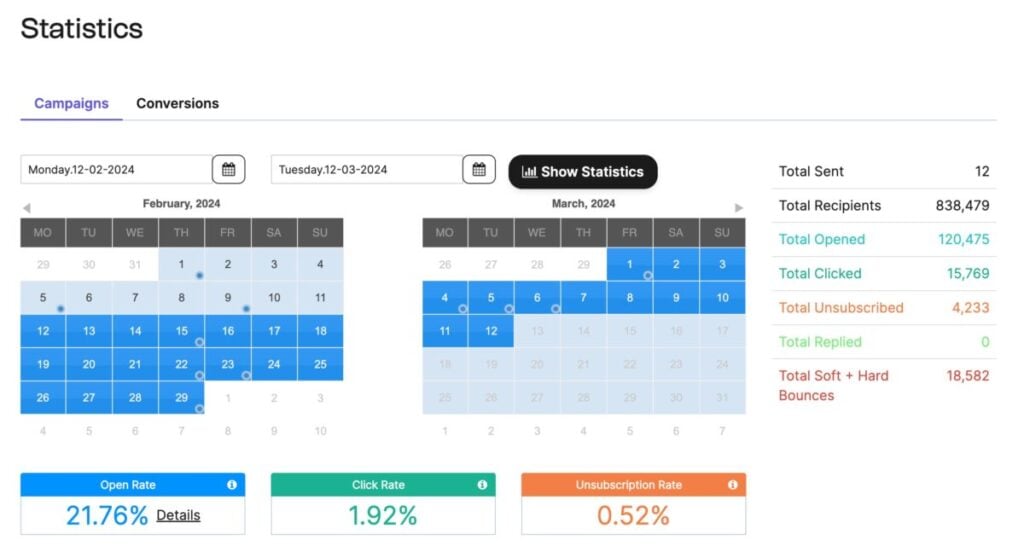
Source: Brevo
Integrations with Your Other Business Tools
Your email and SMS marketing platform should seamlessly integrate with the other tools and systems your business relies on. Klaviyo, for example, offers over 300 integrations, including with popular eCommerce platforms like Shopify and WooCommerce. This allows you to sync customer data and automate workflows across multiple channels, creating a cohesive marketing strategy.
ActiveCampaign also shines in this area with its ability to integrate with nearly 1,000 applications, from Salesforce to Google Analytics. These integrations enable the synchronization of data across platforms, ensuring that your marketing efforts are aligned with your overall business strategy. By choosing a platform that integrates well with your existing tools, you can enhance the effectiveness of your marketing campaigns and improve overall business efficiency.
Wrapping Things Up
If you’re a regular reader of yours truly, you would be quite familiar with email marketing by now. We often cover tips and tools. SMS marketing, though, is an area that we haven’t paid the same attention to.
There are many great email marketing tools, but surprisingly few actually also include SMS marketing features. That being said, the nine that we’ve included in this list are more than capable. Keep in mind usability when testing these different tools. After all, the goal of these types of tools is to save time.
Frequently Asked Questions
What is email marketing software?
Email marketing software is a tool that enables businesses to create, send, and manage email campaigns. It typically includes features for designing emails, automating campaigns, managing subscriber lists, and tracking performance metrics.
What is SMS marketing software?
SMS marketing software allows businesses to send text messages to customers for promotional purposes. It helps manage contact lists, create messages, schedule sends, and analyze response rates.
How do I choose the best email marketing software?
When choosing email marketing software, consider factors such as ease of use, automation capabilities, deliverability rates, customer support, and integration with other tools you use.
What features should I look for in SMS marketing software?
Key features to look for in SMS marketing software include message personalization, automation, compliance with regulations, analytics, and the ability to segment your audience.
Are there free options for email and SMS marketing software?
Yes, many platforms offer free tiers or trials, such as Campaigner and Omnisend. However, these often come with limitations on the number of subscribers or messages.
How can I measure the success of my email marketing campaigns?
You can measure success through metrics such as open rates, click-through rates, conversion rates, and unsubscribe rates. Most email marketing software provides analytics dashboards to help track these metrics.
Comparing Email and SMS Marketing Tools
To get the most out of your email and SMS marketing campaigns, consider exploring the following tools and software:
- 17 of the Best Email Marketing Services
- 20 Email Marketing Automation Tools
- 18 of the Leading Email Automation Tools
- Top 11 Email Relay and Deliverability Providers
- Top 14 AI Email Marketing Platforms
- 21 Email Newsletter Tools
- Top 12 Cold Email Marketing Software Tools
- 18 of the Leading Email Automation Tools









